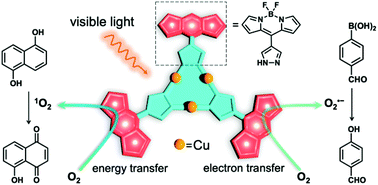Strong visible light-absorbing BODIPY-based Cu(i) cyclic trinuclear sensitizer for photocatalysis†
Abstract
Exploring earth-abundant photosensitizers (PSs) with strong visible light absorption is a long-standing interest, but still challenging. Although copper(I) cyclic trinuclear complexes (Cu-CTCs) have exhibited fascinating photoluminescence properties, their potential application as photosensitizers remains unexplored. Herein, a Cu-CTC (1) bearing boron dipyrromethene (BODIPY) groups was constructed and its photophysical behaviours comprehensively investigated by steady-state spectroscopy, time-resolved transient absorption spectroscopy, and theoretical calculations. The introduction of BODIPY groups in 1 endowed it with a high-lying singlet excited state for strong visible light absorption and long-lived triplet excited states. In addition, highly efficient ISC for populating the long-lived triplet states was achieved by metal-to-ligand charge-transfer (MLCT) singlet and triplet excited states. Cu-CTC without the BODIPY group (2) could not absorb visible light, whereas 1 displayed a high molar extinction coefficient (ε) of 78 515 M−1 cm−1 in the visible light region, which is rarely achieved for Cu-CTCs. Furthermore, 1 exhibited much higher photooxidation activity than that of 2, a conventional noble-metal PS (i.e., Ir(ppy)3) and a well-established Cu(I)-PS (i.e., Cu(phen)2BF4) for both electro- and energy-transfer reactions. Our investigation provides a feasible approach for designing Cu-CTCs as promising photosensitizers.



 Please wait while we load your content...
Please wait while we load your content...